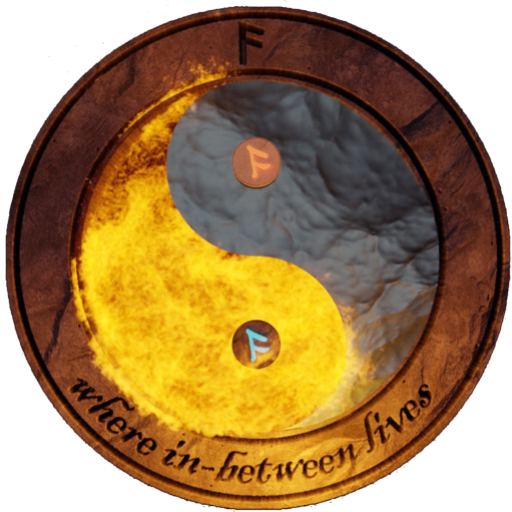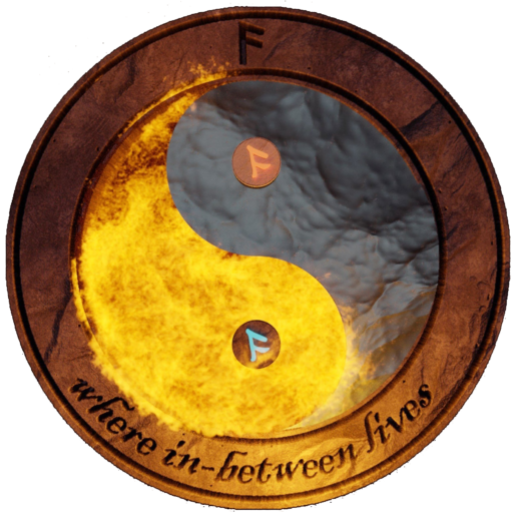
Believe it or don’t, the crafting of the Where In-Between Lives logo involved many hours of research and personal reflection. The logo contains four structural/symbolic elements described here in order of most to perhaps least obvious.
The Title Itself
From our theme song, “The Table Round,”
Our world has become one of extremes. Where there is no room for in-between. Voices at both ends are growing loud.
The political climate in the United States in 2020 served as the proverbial poster child for polarization of views. In a manner reflective of the evolution of our larger society, or perhaps the driving force behind it, binarization of complicated issues seemingly became the accepted and expected norm. Mutual exclusivity of position seemingly rules the day driving diplomacy, compromise, and bipartisanship to near extinction.
To be fair, the tendency to have extreme groups on either side of an issue is as old as humankind. Yet, required membership in the extreme as the rule rather than the exception bothers me greatly. It sometimes seems that disinterest in a particular issue, while allowing one to dedicate limited time and energy to other efforts meaningful to the individual, leave one to be ostracized by both extremes as uninformed, apathetic, or banished to the outgroup by default. And be ready to duck and cover should you see merit in arguments from each side of a contested issue. Synonymous with “caught in the crossfire” today, compromise reflects a dangerous place to want to stand and be heard.
In-Between does not live at the intersection of indecision and apathy, nor reflect an attempt to play both sides of the fence. In-between lives as an openness to learn and grow, understand various perspectives of different stakeholders, and then make an informed choice about one’s position. At the corner of disagreement and civility is Where In-Between Lives. There’s a coffee shop there that offers opportunities to agree to disagree on certain topics yet explore whether commonalities on others may exist. As I get older, I lament the realization that I have missed out on getting to know some uniquely fascinating people because I viewed them in an all-or-none fashion.
Where In-Between Lives is a choice of personal philosophy and dedicated pursuit of the same. I fail miserably at reaching its destination some days, but I have learned how important it is to not lose sight of my goal of living there full time one day.
The Yin-Yang Inlay Within The Table Top
The concept of Yin and Yang is a tool for achieving optimal balance in thought and action by understanding the range of extremes of any quality. This concept pervades Chinese philosophy, language, and medicine.
Adapted From Robert Chuckrow, The Tai Chi Book, YMAA Publication Center, Roslindale, MA, 1998 as documented at https://www.chuckrowtaichi.com/AboutYinYang.html
The profound and expansive symbolism embedded within the “Yin-Yang” represents a topic well-beyond the scope of this blog and certainly well-beyond my limited understanding. Here, the symbol’s use signifies the duality inherent in all things and the paradox presented by opposites combining into a unified whole, with each part dependent on its opposite for meaning and existence. Light, for example, cannot exist without dark, nor can dark exist without light. Darkness absent the concept of light is not darkness at all but rather a void. Yet does a void or nothingness hold any meaning without “somethingness” to define it?
To eradicate one’s opposite is to destroy oneself in the process. Harmony and wholeness exist as a function of the balance of opposing forces and understanding their interdependence. Imbalances yield catastrophe and chaos. For a further exploration of such topics, the reader is encouraged to explore Daoist principles of wu wei, or actionless action, and pu, “the uncarved block.” For an accessible introduction, one should seek out my favorite book, “The Tao of Pooh” by Benjamin Hoff. It is an oversimplification but a fun read and a good place to find inspiration for further study.
At any rate, our logo incorporates the yin-yang to symbolize the importance of finding balance in opposing forces in any attempt to achieve harmony, the conceptualization that the ebb and flow of such forces are interdependent and a necessary part of existence, and the understanding that within the deepest regions of a coveted quality or force exists a piece of its opposite. I will leave it to the reader’s interest to explore the meaning of the counter-clockwise flow of yin and yang within the borders of our logo as well as the significance yang being depicted in the lower position of the circle while yin dominates the upper portion.
The Table Round
While its depiction from above holds no intentional significance, the stone Table as the solid foundation of our logo speaks for itself. Across time and place, the table represents a location where human beings congregate to nourish our bodies, share our life experiences, and achieve common understandings. Most importantly, however, the table is round – it has no defining sides, no hierarchy of power, no positions of superiority. Each point along the outside of the circle is equidistant from the middle, yet hardly the same. Each participant seated at a round table physically and metaphorically sees the table’s center and the other participants from a unique perspective. Some perspectives exist almost without distinction in position or substance from their neighbors, while other perspectives are occupy end points of the table’s diameter and thus appear diametrically opposed. Yet, any attempt to define the starting or ending point of the edge forming the circumference of the table is an exercise in futility. One’s position at the table is just that, a position – a position from which “reality” is uniquely perceived by each individual at that particular moment in time.
Ansuz
The seeming “F” with its horizontal segments slanting downwards represents the Nordic Rune of Ansuz. One need look only to its association with the Norse God, Odin, to understand the importance of this particular rune. Much like the yin-yang, the symbolism and of the rune runs very deep and can represent different meanings that can be highly personal.
As part of our logo, Ansuz represents the diplomatic strength of Odin – the ability to reconcile differences without necessarily having to resort to violence. Ansuz reflects rationality and mental clarity – the concept that communication of ideas and opinions forms the strongest path to learning and heightened understanding. the understanding that dialog and communication of differing opinions.
As Neil Giles explains in his Odin’s Rune’s: The Definitive Rune Handbook,
Ansuz teaches us that we can draw from the external world and adapt to its demands and yet retain our inner power. … It is a rune of magical interactions where ground is given and taken. It shows us how we must connect and adapt to accomplish our purpose. It also shows us where learning and new knowledge are required. Ansuz calls you to the path of knowledge. Learn, grow, expand! Expand not only your ideas but the framework within which they exist. Be intent on listening when Ansuz calls. The phone will ring, letters will come, people will talk. Be intent on talking. Express yourself clearly, speak your mind and your heart. Above all, show a willingness to create a meeting ground for all differences of opinion, attitude, and judgement. … Be willing and supple, yet hold on to the core of your own ideas and beliefs. (pp. 95 – 96)
Giles, Neil (2002). Odin’s Runes. Starburst Publishing: South Australia
Notice how a fiery Ansuz character, symbolic of knowledge of yang, serves as an important piece in the organized and harmonious cyclic flow of the watery yin. Conversely, a watery Ansuz character, representing knowledge of yin, helps keep the movement of yang in balance.
Taken altogether, our logo represents:
- a quest for balance, harmony, and civility in our increasingly polarized world
- through the respectful sharing of opinion, knowledge, and life experience
- at a place where the concepts of right versus wrong – of winning versus losing – are abandoned in favor of gaining a mutual understanding of the perspective from where another human being sits.

491 Comments